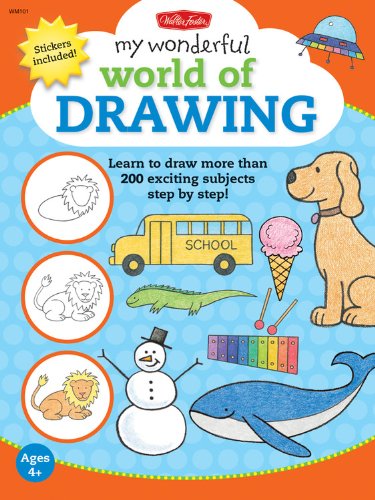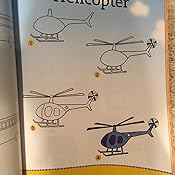With enthusiasm, let’s navigate through the intriguing topic related to Welcome to the Wonderful World of Drawing!. Let’s weave interesting information and offer fresh perspectives to the readers.
Introduction
Welcome to the Wonderful World of Drawing!

Hey there, budding artists! I’m your friendly neighborhood drawing teacher, here to guide you through the exciting journey of creating art with just a pencil and paper. This book is your magical passport to unleashing your creativity and having a ton of fun while you learn!
But first, let’s answer a few questions to make sure we’re on the same page:
- What kind of things do you like to draw? Animals? People? Magical creatures? Knowing your interests helps me tailor our journey!
- Do you have any drawing experience? If you’ve never picked up a pencil before, that’s okay! We’ll start with the basics and build up your skills together.
- What kind of drawing tools do you have? A regular pencil, colored pencils, crayons, markers? We’ll work with whatever you have!

The Magic of Drawing
Drawing isn’t just about making pretty pictures, it’s about expressing yourself, exploring your imagination, and having fun! It’s like a secret language that lets you share your thoughts and feelings with the world. Here are some awesome benefits of drawing:
- Boosts Your Creativity: Drawing lets you imagine anything you want and bring it to life on paper. It’s like having a superpower to create your own worlds!
- Sharpens Your Observation Skills: To draw something accurately, you need to pay close attention to its details. This helps you see the world in a whole new way!
- Improves Your Hand-Eye Coordination: Drawing requires you to control your hand and make precise movements. This helps develop your fine motor skills and makes it easier to do other things like writing and playing musical instruments.
- Reduces Stress and Anxiety: Drawing can be a great way to relax and escape from the everyday world. It allows you to focus on the present moment and let your worries melt away.
- Builds Confidence: As you learn to draw, you’ll discover that you can create amazing things! This builds your self-belief and encourages you to try new things.


Your Drawing Journey Begins!
We’ll start with the basics and gradually build up to more complex drawings. Don’t worry if you make mistakes – that’s part of the learning process! The most important thing is to have fun and enjoy the journey.
Here are some key drawing concepts we’ll explore together:
- Lines: Lines are the building blocks of all drawings. We’ll learn how to draw different types of lines, like straight lines, curved lines, and wavy lines. We’ll also explore how to use lines to create shapes and forms.
- Shapes: Shapes are formed by lines. We’ll learn to draw basic shapes like circles, squares, triangles, and rectangles. We’ll also explore how to combine shapes to create more complex objects.
- Forms: Forms are three-dimensional shapes. We’ll learn how to create the illusion of depth and volume in our drawings by using shading and perspective.
- Values: Values refer to the lightness or darkness of a color. We’ll learn how to use different values to create shadows, highlights, and textures in our drawings.
- Composition: Composition is the arrangement of elements in your drawing. We’ll learn how to create balanced and visually interesting compositions.


Let’s Get Started!
1. Warm-up Exercises:
Before you dive into drawing your favorite things, let’s warm up those drawing muscles!
- Scribble Lines: Grab your pencil and just scribble! Don’t worry about making anything specific, just let your hand move freely across the paper. This helps loosen up your hand and get your creative juices flowing.
- Shape Mania: Draw a bunch of different shapes: circles, squares, triangles, rectangles. Try to make them different sizes and experiment with different ways to draw them.
- Line Games: Draw a long, straight line across your page. Now, draw another line that intersects it. Keep adding lines, making them curved, wavy, or zig-zagging. See what interesting patterns you can create!
2. Basic Shapes:
Now, let’s learn how to draw some basic shapes:
- Circles: Start by drawing a small circle in the center of your paper. Then, practice drawing circles of different sizes and in different positions. Try to make them as smooth and round as possible.
- Squares: Draw a square by making four equal sides that meet at right angles. Practice drawing squares of different sizes and in different positions.
- Triangles: Draw a triangle by making three straight lines that meet at three points. Practice drawing triangles of different shapes and sizes.
- Rectangles: Draw a rectangle by making two pairs of parallel lines. Practice drawing rectangles of different proportions and in different positions.
3. Combining Shapes:
Once you’ve mastered the basics, let’s start combining shapes to create more complex objects!
- House: Start by drawing a rectangle for the base of the house. Then, add a triangle for the roof. You can add windows and a door by drawing smaller rectangles and squares.
- Tree: Start by drawing a brown rectangle for the trunk. Then, draw a green triangle for the top of the tree. You can add branches by drawing smaller lines coming out from the trunk.
- Sun: Draw a big yellow circle for the sun. You can add rays of light by drawing straight lines coming out from the circle.
4. Adding Details:
Now, let’s add some details to our drawings to make them more interesting!
- Eyes: Draw two small circles for the eyes. Then, add a small black circle inside each eye for the pupil.
- Nose: Draw a small triangle for the nose.
- Mouth: Draw a curved line for the mouth.
- Hair: Draw wavy lines for the hair.
5. Shading and Texture:
Shading and texture help to give your drawings depth and realism.
- Shading: Use your pencil to create different values of gray. Start with light pressure for lighter values and use more pressure for darker values.
- Texture: Use your pencil to create different textures, like rough, smooth, bumpy, or fuzzy.
6. Perspective:
Perspective helps to create the illusion of depth in your drawings.
- One-Point Perspective: This is the simplest form of perspective. It uses a single vanishing point on the horizon line. All lines that recede into the distance converge at this point.
- Two-Point Perspective: This uses two vanishing points on the horizon line. All lines that recede into the distance converge at one of these points.
7. Practice, Practice, Practice!
The best way to improve your drawing skills is to practice regularly. Set aside some time each day to draw, even if it’s just for a few minutes. Don’t be afraid to experiment and try new things. The more you draw, the better you’ll become!
FAQs
1. What if I’m not good at drawing?
Everyone starts somewhere! The key is to practice and have fun. Don’t worry about making mistakes – they’re part of the learning process. Just keep drawing and you’ll see your skills improve over time.
2. What kind of pencil should I use?
You can use any pencil you like! A regular #2 pencil is a good starting point. You can also experiment with different pencils, like softer pencils for darker lines and harder pencils for lighter lines.
3. What if I don’t know what to draw?
Look around you for inspiration! Draw things you see in your everyday life, like your pet, your favorite toy, or a flower. You can also draw from your imagination, like a magical creature or a dream you had.
4. How can I make my drawings more interesting?
Experiment with different colors, textures, and perspectives. You can also add details to your drawings, like shadows, highlights, and patterns.
5. What should I do if I get stuck?
Don’t give up! Take a break and come back to your drawing later. You can also ask for help from a teacher or a friend. The most important thing is to keep trying!
Remember, drawing is a journey, not a destination. Enjoy the process, have fun, and don’t be afraid to experiment!

Thus, we hope this article has provided valuable insights into Downloads Welcome to the Wonderful World of Drawing!. We thank you for taking the time to read this article. See you in our next article!
 apapunada.my.id News Bisnis Technology Tutorial
apapunada.my.id News Bisnis Technology Tutorial